Owned by a Greek family since 1976, this old school establishment enjoys a cult reputation by maintaining the pastries and the atmosphere of its prior Hungarian owners.
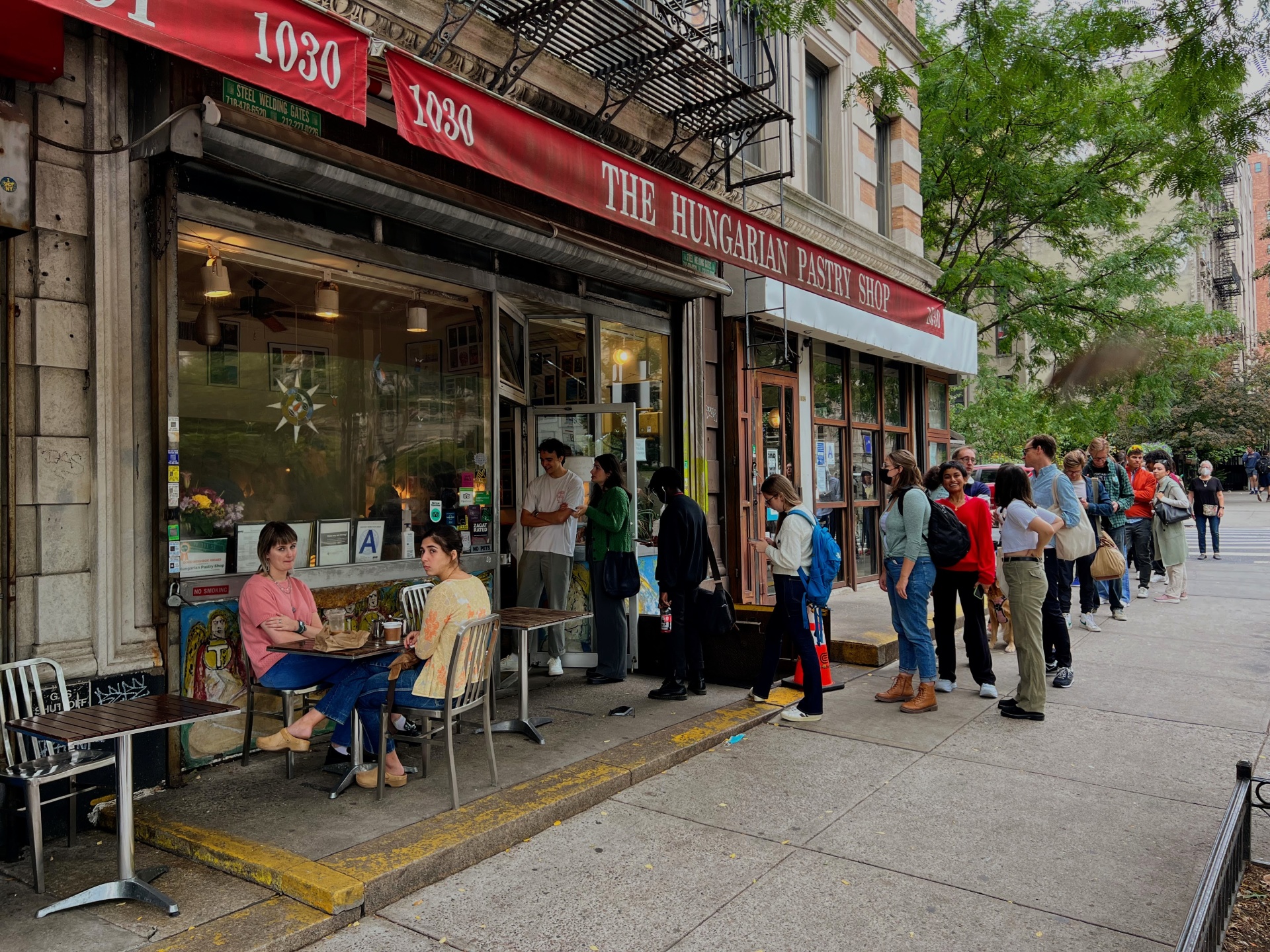
“Get the Rigó Jancsi, it’s very good,” were the parting words of my elderly Hungarian friend, a retired professor of history at Columbia University, after visiting him at his Morningside Heights apartment. This was several years ago and he suggested I go to the nearby Hungarian Pastry Shop, located across the street from the giant Cathedral of St. John the Divine, to try their traditional chocolate cake.
This neighborhood gem with a red-and-white awning has since become my home away from home during extended trips to New York from Budapest. I come here to work, to meet friends, to taste the familiar. I’m not the only one who’s been charmed: no matter the time of day, there’s a line outside. If I’m lucky, it doesn’t reach all the way to the corner of Amsterdam Avenue and 111th Street.
Long gone are the 1940s when dozens of Hungarian restaurants and specialty stores dotted the streets of Upper Manhattan, including the famous Paprika Weiss. The diaspora has since spread out and what was known as “Goulash Avenue” has quietly disappeared. Today, the Hungarian Pastry Shop is one of a handful of establishments still serving the food of the motherland.
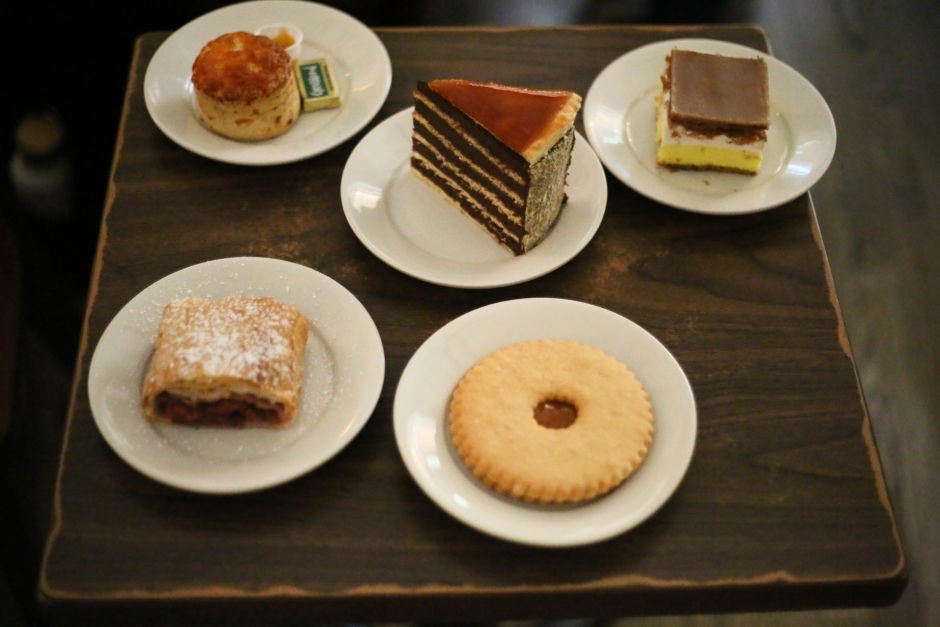
It was launched in 1961 by Ms. Száraz, a native of Hungary, and József Vékony, a Viennese-trained Hungarian baker. Soon, the duo’s Dobos tortes and croissants drew crowds from the nearby campus and the Upper West Side. “Mrs. Száraz, a mother hen to Columbia students and faculty,” wrote the New York Magazine at the time. In 1976, due to József’s ill health, they had to sell the shop. The buyers consisted of three Greek immigrants who liked Hungarian pastries and wanted to keep things going. One of them was a young waiter named Panagiotis Binioris.
Initially, they relied on help from Ms. Száraz. “She was wonderful. She helped us with recipes and anything we needed, without hesitation. She lived right upstairs,” said Panagiotis, now 75, on a recent morning while watering the plants in the window. Panagiotis ran the place for decades – buying out his partners along the way – before passing the torch to his son, Philip, in 2012. “Since the 1970s, customers made me promise that I will never change this place. I told them I will not change it, but they didn’t believe me.”
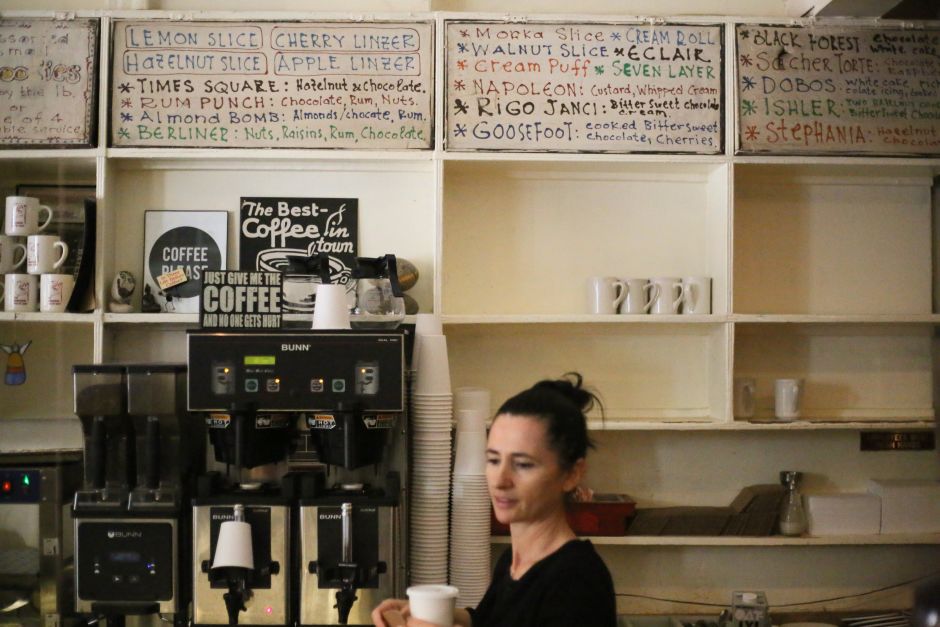
Indeed, little has changed in the past nearly half a century. The name remained, and so did the interior and the assortment. Pogácsa (cheese biscuits), Dobos torte (sponge cake layered with chocolate butter cream and topped with brittle caramel), poppy-seeds strudel, krémes (vanilla custard enclosed by puff pastry), Sacher torte, ischler cookies, and other Austro-Hungarian classics still appear behind the weathered display glass. And also Hamantaschen, a filled Ashkenazi pastry in the shape of a triangle, likely because Ms. Száraz was Jewish-Hungarian.
The Hungarian Pastry Shop has gained a cult reputation over the decades, but reviewers often point out that it’s the ambiance rather than pastries that draw people. Sure, the cakes are on the rich side and don’t rival those at Budapest’s leading confectioneries, but they’re not bad at all. My go-to order is a croissant followed by a sour-cherry strudel. The croissant is denser than the flaky French version, and it has been the best-selling item ever since Ms. Száraz and Mr. Vékony developed the recipe (it’s served with a side of apricot jam and butter).
I was immediately smitten the first time I stepped in, but the Hungarian Pastry Shop isn’t for everyone. If you’re a fan of sleek, Nordic design, for example, this probably isn’t the place for you. Here the inside is crammed with rickety wooden furniture made for tucking yourself into a half-lit corner and sharing your table with strangers. A well-earned patina – vintage cashier, decades-old signs, frilly lamp shades – betrays the place’s long history, but there’s no artificial mythologizing of the past. Everything feels effortless.
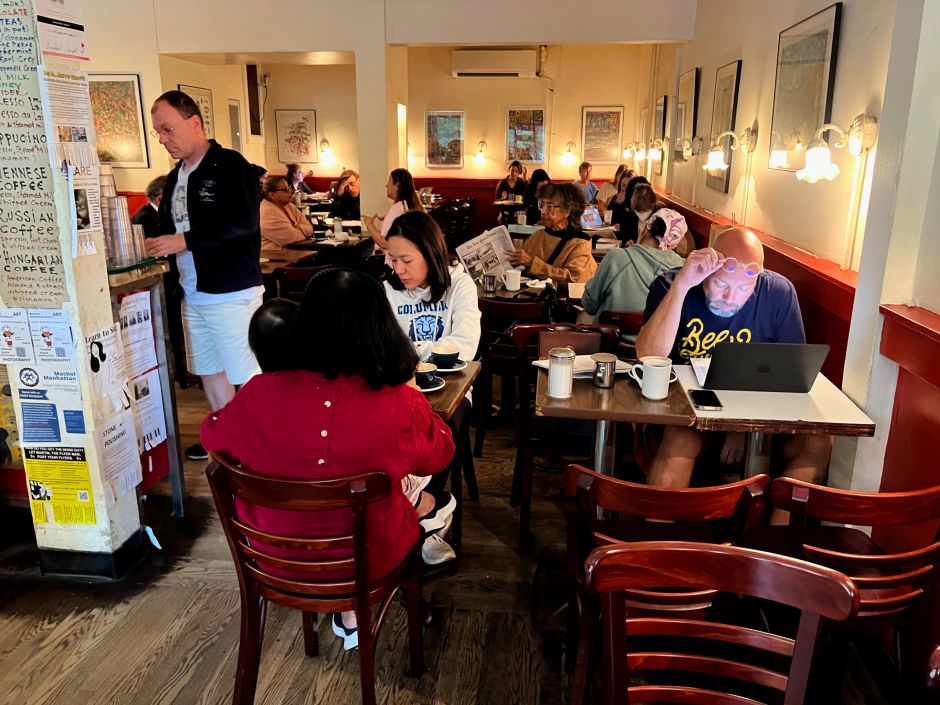
The customers mainly consist of bookish Columbia students from the nearby campus. Some come here to study – no wifi and background music means less distraction – others to gossip with friends, to do crossword puzzles, to wind down with a book. “Other coffee shops on campus are so sterile. Blue Bottle, Joe Coffee, those types of places,” said an undergraduate I shared a table with recently.
Writers too find the intellectual air stimulating, as evidenced by framed book jackets on the walls showing dozens of novels that were composed on the premises. This brainy milieu extends all the way to the bathroom, where personalized quotes by the likes of Albert Camus (“we must [not] imagine Sysyphus happy”) fight for the crowded wall space with less complicated manifestos (“fuck Amazon”).
While the ratio of books per table is higher than at the average café, the Hungarian Pastry Shop is more than just a hub of intellectuals. I’ve sat next to public transportation employees gossiping in hushed tones about unloved superiors; elegantly dressed couples dropping in for coffee before the morning service across the street; sassy Jewish seniors from the Upper West Side with the perfect combination of warmth and bite.
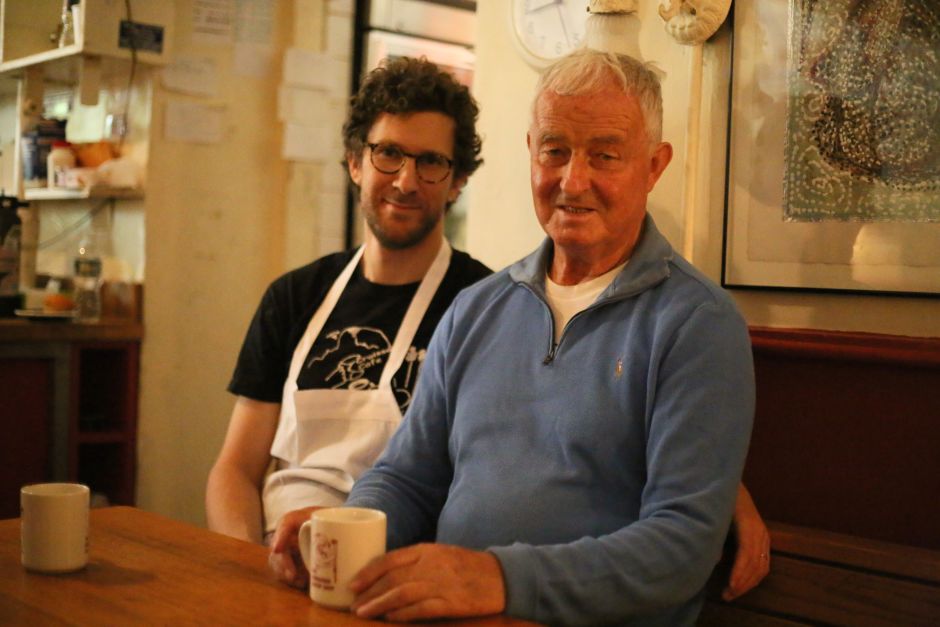
As with every genuine neighborhood hangout, there are a few idiosyncratic regulars. Morgan, for example, the peripatetic elderly man in the worn wool jacket who shuffles back and forth between inside and outside for much of the day. He usually clutches a book – lately it’s St. Augustine’s Confessions – and has a kind word to everyone.
How can they attract such a mixed group? By being affordable. Eight dollars will buy you a generous slice of cake and a coffee. This isn’t exactly cheap, but far from expensive. “We don’t try to cash in on the name and make it out of reach for people,” said Philip. “For three dollars, you can sit with a cup of coffee all day, and no one is going to bother you.” His father agreed. “People can stay as long as they want.” He said this was the norm at the cafés of his youth back in Greece, and now this is the norm here, too.
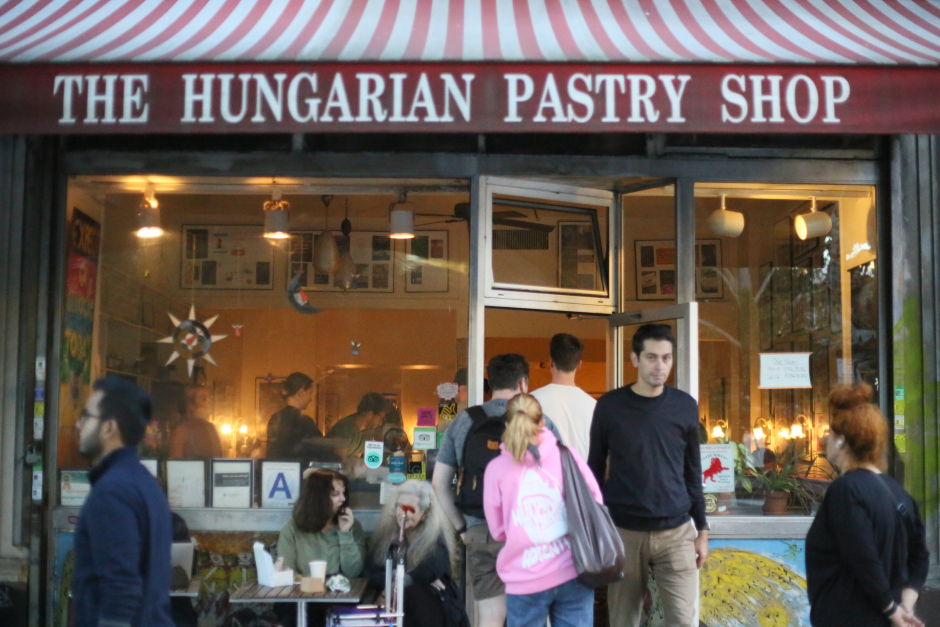
If you didn’t know they were the owners, you wouldn’t guess. They’re both modest and unpretentious. Philip spends much of his days in the back making pastries. “I’m one of the bakers,” he responded when I asked if he was the head baker. He claims he’s learned everything from his father. Panagiotis still shows up every day to help out, except for the winter, which he spends in Florida.
Despite the all-day rush, the servers are calm and friendly. The first time I came here, they pointed me to the “bottomless” coffee pot – free refills – when I wanted to purchase a second cup. It’s a small display of kindness, but rare within the cutthroat capitalism of New York City. (With businesses, the personality of the owner often trickles down to the staff – here, this is a good thing.)
I recently noticed that Rigó Jancsi was no longer made. A server told me customers preferred the regular chocolate cake. “We have to make what people are asking for,” said Philip. But when they remove something, they try to replace it with familiar flavors that belong to the place and its identity. Still, Hungarian visitors are usually upset when they come here, Philip told me. “They aren’t expecting Greek owners. They think we aren’t authentic. The younger tourists think this is cool, but the older ones think we’re lying. But that’s okay.”
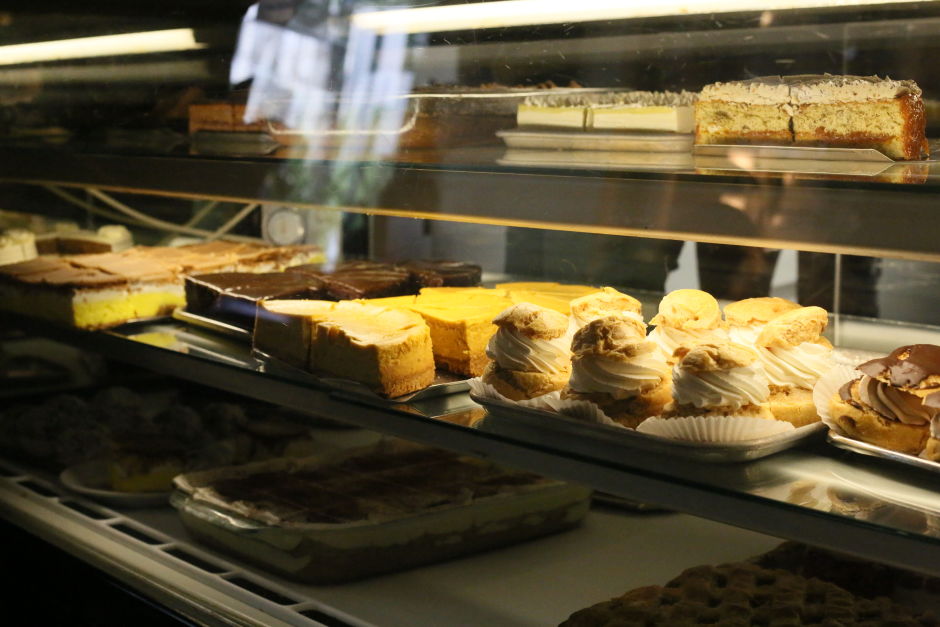
New Yorkers have no such qualms; they love the Hungarian Pastry Shop and appreciate its continued existence within this dynamic city. The other day, an older artist was sitting next to me; when a server came to clear his table, he said to her: “Everything is the same here as it was forty years ago. Except you. You weren’t here then.”